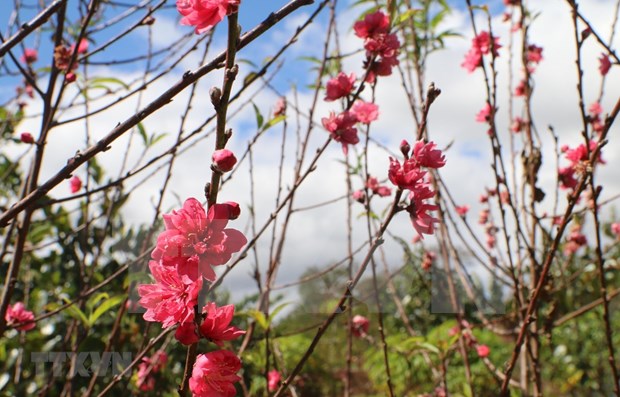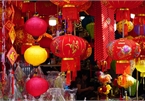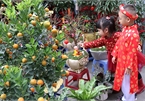 |
|
Peach blossoms on Tet
|
“Tet” is the phonetic deformation of"Tiet", a Sino-Vietnamese term which means "Joint of a bamboostern" and in a wider sense, the "beginning of a period of theyear". The passage from one period to the next may cause a meteorologicaldisturbance (heat, rain, mist) that must be exercised by ritual sacrifices andfestivities. There are many Tets throughout the year (Mid-Autumn Vietnamese NewYear, Cold Food Vietnamese New Year, etc.). But the most significant of all is"Vietnamese New Year", which marks the Lunar New Year.
For the Vietnamese people, the Lunar New Year is like a combination of Western Saint Sylvester, New Year's Day, Christmas,Easter and Thanksgiving. It is the festival of purity and renewal.
1. Cleaning and decorating the home
Homes are often cleaned and decorated before NewYear's Eve. Children are in charge of sweeping and scrubbing the floor. Thekitchen needs to be cleaned before the 23rd night of the last month. Usually,the head of the household cleans the dust and ashes (from incense) from theancestral altars. It is a common belief that cleaning the house will get rid ofthe bad fortunes associated with the old year. Some people would paint theirhouse and decorate with festive items.
2. Getting new clothes
This is often the most exciting part of theLunar New Year among children. Parents usually purchase new clothes and shoesfor their children a month prior to the festival. However, children cannot weartheir new clothes until the first day of the Tet and onward. The best outfit isalways worn on the first day of the year.
3. Farewell ceremony for the Kitchen Gods (Ong Tao)
Seven days (the 23rd night of the last lunarmonth) prior to Tet, each Vietnamese family offers a farewell ceremony for OngTao to go up to Heaven Palace. His task is to make an annual report to the JadeEmperor on the family's affairs throughout the year.
4. Giao Thua (Lunar New Year's Eve)
However, in a literal translation, it means"Passage from the Old to the New Year". It is a common belief amongVietnamese people that there are 12 sacred animals from the zodiac taking turnmonitoring and controlling the affairs of the earth. Thus, Giao Thua (NewYear's Eve) is the moment of seeing the old chief end his ruling term and passhis power to the new chief. Giao Thua is also the time for Ong Tao (KitchenGod) to return to the earth after making the report to the Jade Emperor. Everysingle family should offer an open-air ceremony to welcome him back to theirkitchen.
5. Xong Dat (Aura of the Earth)
“Giao Thua” is the most sacred time of the year. Therefore, the first houseguest to offer the first greetings is very important. If that particular guest has a good aura (well respected, well educated, successful, famous, etc.), then the family believes that they will receive luck and good fortune throughout the year. The belief of “Xong Dat” still remainsnowadays, especially among families with businesses.
6. Hoa Mai and Hoa Dao (apricot and peachflowers)
Flower buds and blossoms are the symbols for newbeginning. These two distinctive flowers are widely sold and purchased duringTet. Hoa Mai are the yellow apricot flowers often seen in the southern. Hoa Maiare more adaptable to the hot weather of southern regions, thus, it is known asthe primary flower in every home. Hoa Dao are the warm pink of the peachblossoms that match well with the dry, cold weather in the north. Tet is notTet if there is no sight of Hoa Mai (south) or Hoa Dao (north) in every home.
7. Giving away lucky money in red envelopes
This is a cultural practice that has beenmaintained for generations. The red envelopes symbolise luck and wealth. It isvery common to see older people giving away red envelopes with lucky moneyinside to younger people. The older ones would return good advice and words ofwisdom, encouraging the younger ones to keep up with the schoolwork, liveharmoniously with others, and obey their parents. This greeting ritual is knownas “Mung Tuoi”, honoring the achievement of another year to one's life.
8. Making offerings for the ancestors
This ceremony is held on the first day of theNew Year before noontime. The head of the household should perform the properritual (offering food, wine, cakes, fruits, and burn incense) to invite thesouls of the ancestors to join the celebration with the family. This is thetime families honor the souls of their ancestors and present the welfare of thefamily.
9. Traditional special foods
One of the most traditional special foods forTet is Banh Chung or sticky rice cake. Banh Chung is made of sticky rice, porkand green bean, wrapper inside a special leaf called Dong and boiled for about12 hours. Making the Banh Chung requires care and precision in every step. Therice and green bean has to be soaked in water for a day to make it stickier.The pork is usually seasoned with pepper for several hours. Squaring off andtying the cakes with bamboo strings require skillful hands to make it a perfectsquare. Banh Chung is a must among other foods to be placed on the ancestors’altars during Tet holiday./.

What to know about Tet holiday in Vietnam?
You should know do's and don'ts to avoid awkward moments in Vietnam during Tet celebration.

Tet in a Hanoi family: Out with the old, in with the new
Tet is a magic time when ancient customs and beliefs live on, Thuy Duong tell us about how a family in Hanoi celebrates a typical traditional Tet.
 The festival which best epitomises Vietnam's cultural identity is the Lunar New Year or Tet, with a lot of meaningful customs and traditional special foods.
The festival which best epitomises Vietnam's cultural identity is the Lunar New Year or Tet, with a lot of meaningful customs and traditional special foods.